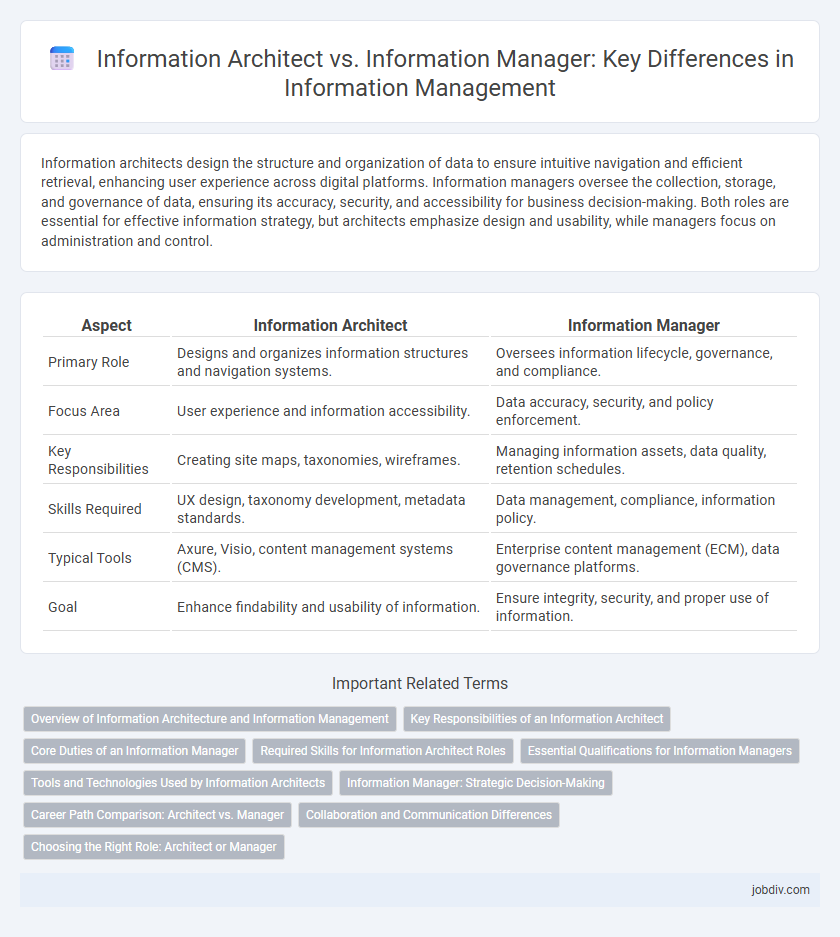Information architects design the structure and organization of data to ensure intuitive navigation and efficient retrieval, enhancing user experience across digital platforms. Information managers oversee the collection, storage, and governance of data, ensuring its accuracy, security, and accessibility for business decision-making. Both roles are essential for effective information strategy, but architects emphasize design and usability, while managers focus on administration and control.
Table of Comparison
| Aspect | Information Architect | Information Manager |
|---|---|---|
| Primary Role | Designs and organizes information structures and navigation systems. | Oversees information lifecycle, governance, and compliance. |
| Focus Area | User experience and information accessibility. | Data accuracy, security, and policy enforcement. |
| Key Responsibilities | Creating site maps, taxonomies, wireframes. | Managing information assets, data quality, retention schedules. |
| Skills Required | UX design, taxonomy development, metadata standards. | Data management, compliance, information policy. |
| Typical Tools | Axure, Visio, content management systems (CMS). | Enterprise content management (ECM), data governance platforms. |
| Goal | Enhance findability and usability of information. | Ensure integrity, security, and proper use of information. |
Overview of Information Architecture and Information Management
Information Architecture involves designing and structuring information systems to enhance usability and findability, focusing on organizing content, navigation, and metadata frameworks. Information Management encompasses the collection, storage, governance, and efficient utilization of data to support business operations and decision-making processes. Both disciplines are essential for optimizing data flow and ensuring information is accessible, accurate, and secure across an organization.
Key Responsibilities of an Information Architect
Information Architects design and structure information systems to enhance user experience by organizing content logically and intuitively. They develop navigation schemas, metadata frameworks, and taxonomies to ensure information is accessible and easy to find. Their role involves collaborating with UX designers and developers to create wireframes, site maps, and content models that align with user needs and business goals.
Core Duties of an Information Manager
An Information Manager primarily oversees the organization, storage, and retrieval of data within an organization to ensure easy access and security. Core duties include developing and implementing information policies, managing data governance frameworks, and coordinating with IT teams to maintain databases and protect sensitive information. They also analyze information workflows to optimize knowledge sharing and support decision-making processes across departments.
Required Skills for Information Architect Roles
Information Architects require expertise in user experience (UX) design, data modeling, and content strategy to effectively structure and organize information for digital platforms. Proficiency in wireframing tools, taxonomies, metadata schemas, and information flow analysis is essential for creating intuitive navigation and enhancing findability. Strong analytical skills and an understanding of human-computer interaction principles are crucial for optimizing information architecture focused on user needs.
Essential Qualifications for Information Managers
Essential qualifications for Information Managers include a strong background in data management, information governance, and strategic planning, often supported by degrees in information science or business administration. Proficiency in information systems, database management, and compliance with privacy regulations is crucial for effective oversight and decision-making. Leadership skills and experience in coordinating cross-functional teams enhance their ability to optimize information usage within an organization.
Tools and Technologies Used by Information Architects
Information Architects primarily utilize tools like wireframing software (e.g., Axure, Sketch) and content management systems (CMS) to structure and organize digital information effectively. They often employ user experience (UX) design tools such as Adobe XD and Figma to create intuitive navigation and information hierarchies. Familiarity with taxonomy management tools and analytics platforms like Google Analytics is essential for optimizing information flow and user interaction.
Information Manager: Strategic Decision-Making
Information Managers play a crucial role in strategic decision-making by overseeing the collection, organization, and analysis of data to support business objectives. Their expertise in data governance, information flow optimization, and stakeholder communication ensures that accurate and relevant information informs management decisions. Unlike Information Architects who focus on structuring information systems, Information Managers align information resources with organizational strategy to drive effective outcomes.
Career Path Comparison: Architect vs. Manager
Information Architects design and structure the organization's data frameworks to optimize user experience and accessibility, requiring skills in user research, wireframing, and data modeling. Information Managers oversee the governance, quality, and strategy of information assets, focusing on data compliance, lifecycle management, and cross-department collaboration. The career path for Information Architects often progresses into roles like UX Designer or Data Strategist, while Information Managers tend to advance toward Data Governance Lead or Chief Information Officer positions.
Collaboration and Communication Differences
Information Architects design the structural framework of information systems, emphasizing user experience and data organization for seamless access. Information Managers focus on overseeing the lifecycle of data, ensuring accuracy, compliance, and strategic use across departments. Collaboration for Architects involves working closely with UX designers and developers, while Managers coordinate with stakeholders and data governance teams to align information policies and practices.
Choosing the Right Role: Architect or Manager
Choosing between an Information Architect and an Information Manager depends on your organizational needs and goals. Information Architects specialize in designing the structure, navigation, and usability of information systems, enhancing user experience and information retrieval. Information Managers focus on overseeing information governance, data quality, and compliance, ensuring that information assets are effectively maintained and utilized.
Information Architect vs Information Manager Infographic

 jobdiv.com
jobdiv.com